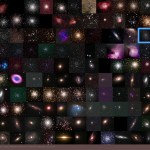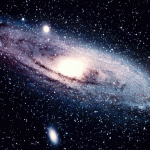local group
"Let the great world spin for ever down the ringing grooves of change." -Alfred Lord Tennyson
Welcome back, for another Messier Monday here on Starts With A Bang! Each Monday, we've been taking a look at one of the 110 Deep-Sky Objects that make up the Messier catalogue, a mix of clusters, nebulae, galaxies and more, all visible from most locations on Earth with even the most basic of astronomical equipment.
Image credit: Greg Scheckler, from his 2008 Messier marathon, where he nabbed 105/110.
When you think of our local group of galaxies, you probably think of the Milky Way and Andromeda…
"Not even light can escape such hollowing, this huge mass in a small space. Even the Milky Way with its open arms is said to have a black hole at its heart." -Susan B.A. Somers-Willett
Our Milky Way is home to us all. With its hundreds of billions of stars, massive spiral arms, dust lanes, and orbiting globular clusters, it's no wonder that nearly everything we see in the night sky is contained within it.
Image credit: All rights reserved by Flickr user Greg Booher.
I say nearly everything, of course, because there are a few exceptions. The Andromeda Galaxy, for one, as well as…
Cameras, CCDs, prisms, grisms, etc., are all some of the instruments that can go on top of telescopes to help us see things better. We haven't really increased the size of telescopes so much as we have the quality and ability of the apparatus that go atop them. Take a look at various pictures I've stolen off the web, all taken by (avid) amateur astronomers in different years. The pictures are of M81 and M82, two galaxies in a group that make up possibly the nearest cluster of galaxies outside of the local group. (The closest is either the M81 group, the Centaurus group, or the IC 342 group.)…
The Milky Way galaxy is a relatively big spiral galaxy. So is Andromeda. There are about 20 dwarf galaxies that are gravitationally bound to us; combined with us, all of this makes up the local group. But Andromeda is moving towards us, and eventually, it's going to merge with us. I'll once again show you a video of what this merger might look like:
But what would we see, here in the Milky Way, as Andromeda got closer and closer to us? Right now, Andromeda looks like this:
But Andromeda is also very far away: about 2.3 million light years (770 kpc). The center of it is tiny on the sky, but…



